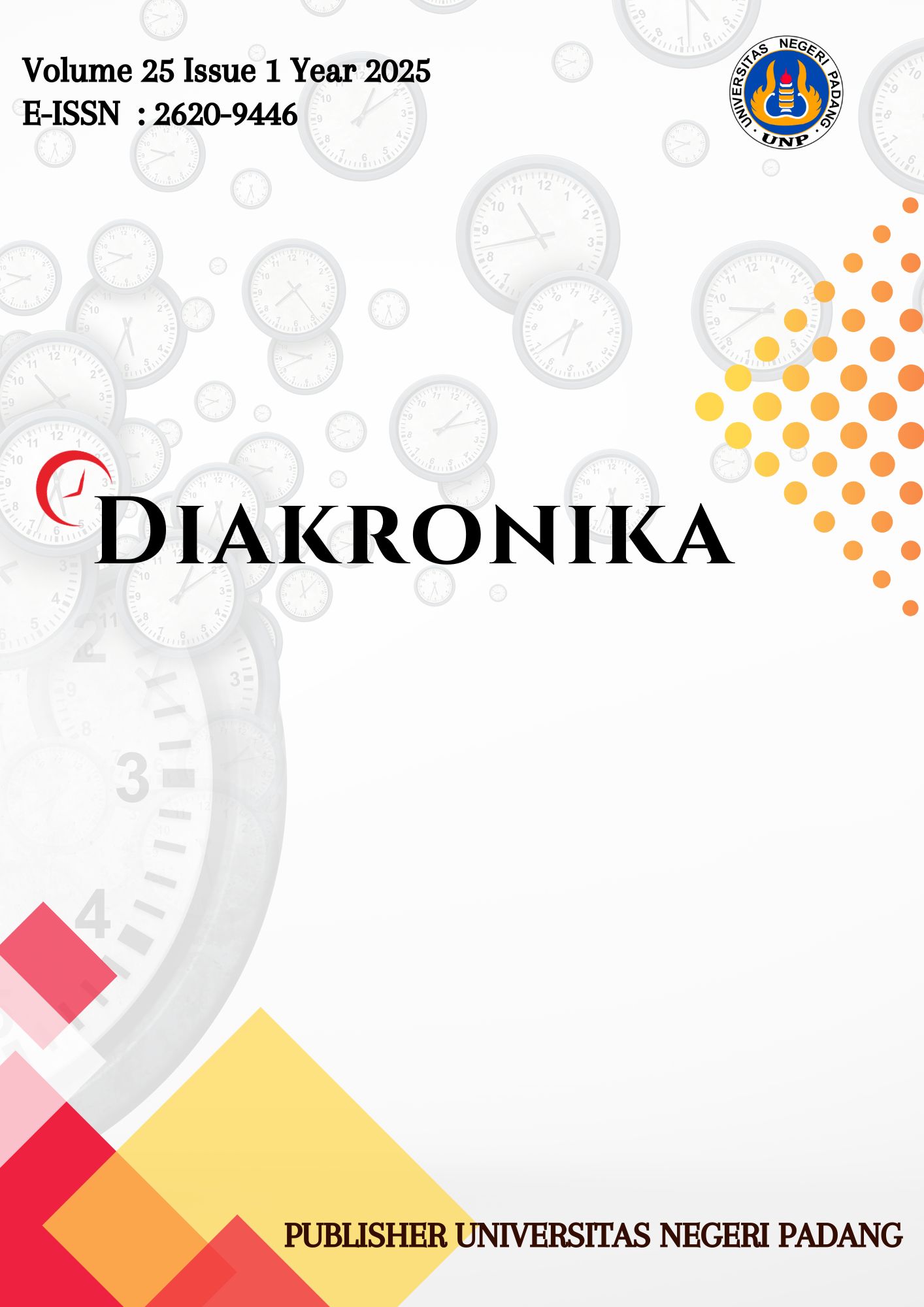Building a Critical Thinking Generation: Developing an Innovative History Learning Model
Abstract
In this digital era, many historical narratives are vulnerable to misinformation and biased interpretations that circulate freely on social media and online platforms. This requires students to develop critical thinking skills that can be improved through history learning. This study aims to develop teaching materials based on conceptual achievement and creative problem-solving models to improve students' critical thinking skills in history learning. The method used in this study is R&D with the ADDIE model. In the analysis stage, the process involves identifying core problems and understanding students' needs. The design stage focuses on planning teaching materials. The actual instructional product is created during the development stage, including content, media, and student activities. The implementation stage involves testing the developed teaching materials in a real classroom environment (conducted on 32 grade XI students of SMA Labschool Jakarta). Finally, the evaluation stage assesses the effectiveness of the teaching materials in meeting the intended learning objectives. The study's results showed that the developed teaching materials effectively improved students' critical thinking skills, as evidenced by a significant increase in pretest and posttest scores (p-value < 0.05). Further effectiveness was measured using N-gain analysis, which indicated effectiveness in the moderate category, with a 32% increase. Expert validation from content and media specialists also confirmed a very high level of feasibility (> 80%). Thus, teaching materials focusing on conceptual achievement and creative problem-solving can be an alternative to traditional history learning, encouraging students to think critically and gain a deeper understanding of history.
Downloads
References
Aqila, N. M. N. (2023, May 23). Post-truth, ancaman serius bagi kredibilitas informasi. ITS News.
Arikunto, S. (2018). Dasar-Dasar Evaluasi Pendidikan. Bumi Aksara.
Asy, ari, Wikanta, W., Fitrah Juniawan, M., & Budi Sartika, S. (2022). Concept attainment model (CAM) empowers critical thinking skills and mastery of concepts for high school students. Science Education Journal (SEJ), 6(2). https://doi.org/10.21070/sej.v%vi%i.1625
Baumgarten, L. (2017). Historical learning in History teaching: some considerations. Critica Historica, VIII(15).
Dai, D. Y., Cheng, H., & Yang, P. (2019). QEOSA: A pedagogical model that harnesses cultural resources to foster creative problem-solving. In Frontiers in Psychology (Vol. 10, Issue MAR). Frontiers Media S.A. https://doi.org/10.3389/fpsyg.2019.00833
De Vos, E., Baccarne, B., & Emmanouil, M. (2021). Creative problem-finding: A shift in focus for creative tools. In H. Grierson, E. Bohemia, & L. Buck (Eds.), International conference on engineering and product design education. The design society a worldwide community. https://doi.org/10.35199/EPDE.2021.72
Fadli, M. R., Rochmat, S., Sudrajat, A., Aman, Rohman, A., & Kuswono. (2022). Flipped classroom in history learning to improve students' critical thinking. International Journal of Evaluation and Research in Education, 11(3), 1416–1423. https://doi.org/10.11591/ijere.v11i3.22785
Fahruddin, F., Rosidi, Moh. I., Fitroh, I., Darsono, D., & Saefudin, A. (2024). Transforming History Education: Enhancing Student Engagement and Literacy through Interactive Methods. SAR Journal - Science and Research, 396–403. https://doi.org/10.18421/SAR74-14
Fajari, S. L. E. W., & Chumdari. (2021). Critical thinking skills and their impacts on elementary school students. Malaysian Journal of Learning and Instruction, 18(2), 161–187. https://doi.org/10.32890/mjli2021.18.2.6
Firza, F., & Aisiah, A. (2019). Error of proposal writing by students. 3rd Asian Education Symposium (AES 2018),
Habib, H. (2019). Effectiveness of Concept Attainment Teaching Model on Achievement of XII Standard Students in Social Sciences. Shanlax International Journal of Education, 7(3), 11–15. https://doi.org/10.34293/education.v7i3.415
Hakim, M. F. Al, Sariyatun, S., & Sudiyanto, S. (2018). Constructing students' critical thinking skills through discovery learning models and contextual teaching and learning model as solution of problems in learning history. International Journal of Multicultural and Multireligious Understanding, 5(4), 175. https://doi.org/10.18415/ijmmu.v5i4.240
Hasan, S. H. (2012). Pendidikan sejarah Indonesia: Isu dalam ide dan pembelajaran (A. Mulyana, Ed.; Cetakan I). Rizqi Press.
Hsieh, C. Y. (2018). Developing Design through a Creative Problem-Solving Process: A Group Community Art Project. International Journal of Art and Design Education, 37(3), 541–553. https://doi.org/10.1111/jade.12155
Johnson, M. (2020). Attainment model: A framework for effective learning. Educational Research Quarterly, 52(3), 201–215.
Jones, A., & Brown, K. (2018). Enhancing critical thinking skills through history education. History Review, 30(4), 267–280.
Kaur, R. (2017). Effect of concept attainment model on achievement of secondary school students in physics. Indian Journal of Applied Research, 7(12), 242–243. https://www.worldwidejournals.com/indian-journal-of-applied-research-(IJAR)/recent_issues_pdf/2017/December/December_2017_1512118360__148.pdf
Karima, E. M., Nurlizawati, N., Firza, F., Abidin, N. F., & Ibrahim, Y. (2024). Reducing Cognitive Bias of Pre-Service History Teachers through Augmented Reality. JOIV: International Journal on Informatics Visualization, 8(1), 520-525.
Khalid, M., Saad, S., Abdul Hamid, S. R., Ridhuan Abdullah, M., Ibrahim, H., & Shahrill, M. (2020). Enhancing creativity and problem-solving skills through creative problem-solving in teaching mathematics. Creativity Studies, 13(2), 270–291. https://doi.org/10.3846/cs.2020.11027
Kholison, M., Suja, A., Setyawan, C. E., & Hantoro, R. R. (2023). Pengembangan bahan ajar bahasa Arab dengan pendekatan kemahiran berbicara. Lahjah Arabiyah: Jurnal Bahasa Arab Dan Pendidikan Bahasa Arab, 4(1), 90–102. https://doi.org/10.35316/lahjah.v4i1.90-102
Kochhar, S. K. (2008). Pembelajaran sejarah terjemahan Purwanta dan Yovita Hardiwati (A. A. Nusantara, Ed.). Grasindo.
Koshyk, O. B., & Petriv, G. V. (2022). Methods of critical thinking development when studying history. Gumanitarni Studii: Pedagogika, Psihologia, Filosofia, 13(4).
Lee, T., O'Mahony, L., & Lebeck, P. (2023). Creative problem-solving everyday dinamics and practice. In T. Lee, L. O'Mahony, & P. Lebeck (Eds.), Creativity and innovation (pp. 117–147). Palgrave Macmillan.
Lin, C.-Y. (2017). Threshold Effects of Creative Problem‐Solving Attributes on Creativity in the Math Abilities of Taiwanese Upper Elementary Students. Education Research International, 2017(1). https://doi.org/10.1155/2017/4571383
López-Fernández, C., Tirado-Olivares, S., Mínguez-Pardo, R., & Cózar-Gutiérrez, R. (2023). Putting critical thinking at the center of history lessons in primary education through error- and historical thinking-based instruction. Thinking Skills and Creativity, 49. https://doi.org/10.1016/j.tsc.2023.101316
Mina, D. R., Rathod, H., & Sahayak, A. (2022). The effectiveness of Concept Attainment Model in teaching Social Science subject. In International Journal of Research in all Subjects in Multi Languages (Vol. 156, Issue 1). www.raijmr.com
Ni, L. B. (2023). Adapting History Education for the 21st Century: Integrating Technology and Critical Thinking Skills. Jurnal Spekta, 4(2), 216. https://doi.org/10.12198/spekta.v4i2.8572
Noreen, Z., & Chaudhary, A. H. (2022). Study of effectiveness of concept attainment model of teaching on academic achievement in economics. Journal of Educational Sciences and Research, 44–60. https://doi.org/10.52587/jesar.08.02.04
Razi, F., Rusdi, R., & Fachruddin, M. (2022). Penerapan model concept attainment untuk meningkatkan hasil belajar pada materi segitiga dan segiempat. JKPM (Jurnal Kajian Pendidikan Matematika), 7(2), 255. https://doi.org/10.30998/jkpm.v7i2.13093
Setiyowati, Y., & Shodikin, A. (2022). Analysis of Student's Critical Thinking Ability in Solving HOTS (Higher-Order Thinking Skills) Problems with Creative Problem-Solving Model. Jurnal Inovasi Pendidikan Dan Pembelajaran Matematika, 8(1).
Smith, J. (2019). The role of creative problem solving in education. Journal of Educational Psychology, 45(2), 123–135.
Tolkacheva, E. A., & Ivanov, S. G. (2022). Teaching materials in the implementation of the technology «learning through teaching». Development of Education, 5(4), 79–86. https://doi.org/10.31483/r-104328
Umar, F. (2024). Engaging with History in the Digital Age: A Study of Technology-Based Distance Learning in History. Journal of Policy Research, 10(2), 873–878. https://doi.org/10.61506/02.00308
Utari, S. W. H., Dwijanto, D., & Dewi, N. R. (2023). Improving Mathematical Creative Thinking Ability In Creative Problem Solving Model With Scaffolding Strategy. Mathline : Jurnal Matematika Dan Pendidikan Matematika, 8(1), 137–152. https://doi.org/10.31943/mathline.v8i1.363
Van Hooijdonk, M., Mainhard, T., Kroesbergen, E. H., & Van Tartwijk, J. (2023). Creative problem solving in primary school students. Learning and Instruction, 88. https://doi.org/10.1016/j.learninstruc.2023.101823
Ward, T. B. (2023). Creative problem solving. In R. Reiter-Palmon & S. Hunter (Eds.), Handbook of organizational creativity (Second, pp. 73–91). Elsevier.





